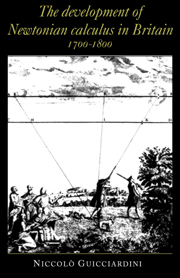Book contents
- Frontmatter
- Contents
- Introduction
- OVERTURE: NEWTON'S PUBLISHED WORK ON THE CALCULUS OF FLUXIONS
- PART I THE EARLY PERIOD
- 1 THE DIFFUSION OF THE CALCULUS (1700–30)
- 2 DEVELOPMENTS IN THE CALCULUS OF FLUXIONS (1714–33)
- 3 THE CONTROVERSY ON THE FOUNDATIONS OF THE CALCULUS (1734–42)
- PART II THE MIDDLE PERIOD
- PART III THE REFORM
- CONCLUSION
- APPENDIX A TABLES OF CONTENTS OF FLUXIONARY TEXTBOOKS
- APPENDIX B PRICE LIST OF MATHEMATICAL BOOKS PRINTED FOR JOHN NOURSE
- APPENDIX C CHAIRS IN THE UNIVERSITIES
- APPENDIX D MILITARY ACADEMIES
- APPENDIX E SUBJECT INDEX OF PRIMARY LITERATURE
- APPENDIX F MANUSCRIPT SOURCES
- Notes
- Bibliography
- Index
1 - THE DIFFUSION OF THE CALCULUS (1700–30)
from PART I - THE EARLY PERIOD
Published online by Cambridge University Press: 14 September 2009
- Frontmatter
- Contents
- Introduction
- OVERTURE: NEWTON'S PUBLISHED WORK ON THE CALCULUS OF FLUXIONS
- PART I THE EARLY PERIOD
- 1 THE DIFFUSION OF THE CALCULUS (1700–30)
- 2 DEVELOPMENTS IN THE CALCULUS OF FLUXIONS (1714–33)
- 3 THE CONTROVERSY ON THE FOUNDATIONS OF THE CALCULUS (1734–42)
- PART II THE MIDDLE PERIOD
- PART III THE REFORM
- CONCLUSION
- APPENDIX A TABLES OF CONTENTS OF FLUXIONARY TEXTBOOKS
- APPENDIX B PRICE LIST OF MATHEMATICAL BOOKS PRINTED FOR JOHN NOURSE
- APPENDIX C CHAIRS IN THE UNIVERSITIES
- APPENDIX D MILITARY ACADEMIES
- APPENDIX E SUBJECT INDEX OF PRIMARY LITERATURE
- APPENDIX F MANUSCRIPT SOURCES
- Notes
- Bibliography
- Index
Summary
at the beginning of the eighteenth century, Newtonian Natural Philosophy began to spread all over Europe. In Great Britain an astonishing amount of interest was shown in the new science. A great number of lectures were given both in and outside London. The role of the fluxional calculus in this process of reinterpretation and popularization was negligible. Quite understandably, a technical subject did not attract the audiences who gathered to attend the lectures on Natural Philosophy.
However, a group of ‘philomaths’ was already active in the seventeenth century. They were most likely interested in Newton's mathematical theory; and, when properly instructed, they were probably able to develop the calculus of fluxions. But in the later years of the seventeenth century the Newtonian calculus could only have been known to Newton's correspondents, such as Collins, Oldenburg and Wallis. Manuscript copies of parts of Newton's work on fluxions were in circulation. The few who were allowed to glance at them, such as Craige, Fatio and David Gregory, were able to grasp just a fraction of Newton's achievements.
Needless to say, the first persons to try and systematize this information in the form of a treatise had to use as their sources the Acta Eruditorum and L'Hospital's Analyse (1696). Particularly remarkable were the attempts of Cheyne (1703) and Hayes (1704).
In later years the calculus enjoyed a time of great popularity thanks to the priority controversy with Leibniz.
- Type
- Chapter
- Information
- Publisher: Cambridge University PressPrint publication year: 1989



